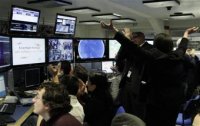
Mini-Big Bangs created in cosmos origins project
(Reuters) - Physicists smashed sub-atomic particles into each other with record energy on Tuesday, creating thousands of mini-Big Bangs like the primeval explosion that gave birth to the universe 13.7 billion years ago.
Scientists and engineers in control rooms across the sprawling European Center for Nuclear Research (CERN) near Geneva burst into applause as the $9.4 billion project to probe the origins of the cosmos scored its first big success.
"This opens the door to a totally new era of discovery," said CERN's director of research Sergio Bertolucci. "It is a step into the unknown where we will find things we thought were there and perhaps things we didn't know existed."
"It just shows what we can do in pushing knowledge forward on where we came from, how the early universe evolved," CERN Director-General Rolf Heuer said, speaking, like Bertolucci, on a video relay from Tokyo.
Colorful images of the collisions, at the center of the Large Hadron Collider (LHC) project which will continue for over a decade, were flashed onto screens across CERN.
CERN scientists say the images reflect what happened a fraction of a second after the Big Bang as matter and energy was spewed out, leading to the formation of galaxies stars and planets, and eventually the appearance of life.
HUGE VOLUMES OF DATA
Over the coming months and years some 10,000 researchers in laboratories around the globe, as well as at CERN, will analyze the huge volumes of data that will be produced from billions of LHC particle collisions to see how that happened.
Among stuff of the universe they hope to track down are invisible dark material making up 25 percent of the cosmos, a particle dubbed the Higgs boson that gives mass to matter, and perhaps new dimensions to add to the four already known.
"These are the known unknowns, but there are unknown unknowns out there which could make us radically revise our view of how the universe works," Bertolucci said.
Soon after 1100 GMT (7 a.m. EDT) on Tuesday, and after two efforts earlier in the day were aborted due to technical glitches, the LHC slammed beams of particles together at a collision energy of 7 TeV, or 7 million electron volts.
This was three and a half times more than ever achieved in a particle accelerator. The particle beams were traveling at a fraction under the speed of light when they hit each other in a tunnel 100 meters (330 feet) under the Swiss-French border.
Oliver Buchmueller, a German physicist on the project, said hard information on what the many billions of collisions over the coming years reveal would emerge only slowly.
"But by the end of 2010 we think we will find evidence of dark material," he added. The Higgs boson was likely to prove more elusive, and perhaps appear only after 2013, when the collider is boosted to collision energy of 14 TeV.
The boson is named after Scottish physicist Peter Higgs, who proposed it three decades ago to explain how the disparate matter produced by the Big Bang was converted to mass.
The earlier delays were due to problems with the power supply and an over-sensitive magnet safety system. This led the physicists to suspend the mega-power particle collisions.
CERN officials insisted it was not a repeat of a major incident in September 2008 that seriously damaged parts of the LHC and delayed the full launch of the project until now.
They also dismissed suggestions from some outside scientists -- echoed by doomsday theorists -- that the fleeting mini-black holes that the project is likely to produce could sooner or later swallow up the Earth.
(Writing by Robert Evans and Jonathan Lynn)






 Front Desk
Front Desk
 Louis Louis
Louis Louis
 Elias Sahyoun
Elias Sahyoun
 Solange El-jbeily
Solange El-jbeily
